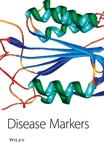MRP1 but Not MDR1 Is Associated with Response to Neoadjuvant Chemotherapy in Breast Cancer Patients
Abstract
A major problem in the treatment of breast cancer is the development of resistance to chemotherapeutic agents. Although the role of multidrug resistance 1 (MDR1) and multidrug resistance associated protein 1 (MRP1) in inducing drug resistance in many cancers has been widely investigated the clinical significance of expression of these genes in breast cancer remains unclear and the data is still controversial. We investigated the expression of MDR1 and MRP1 in breast cancer patients as well as the possible correlation between MDR1 and MRP1 and clinical response to chemotherapy. In the present study, MDR1 and MRP1 gene expression were investigated by real time reverse transcription polymerase chain reaction (RT-PCR) assay in 54 breast cancer tumors and in corresponding adjacent normal tissues before neoadjuvant chemotherapy. The expression level of MDR1 and MRP1 were significantly higher in breast tumors than normal breast tissues. Although a significant relationship was found between the MRP1 expression and response to treatment no association was observed between MDR1 expression and response to treatment. MDR1 and MRP1 expression levels have been shown to be independent of tumor size, histological grade and the status of progesterone or estrogen receptor.




